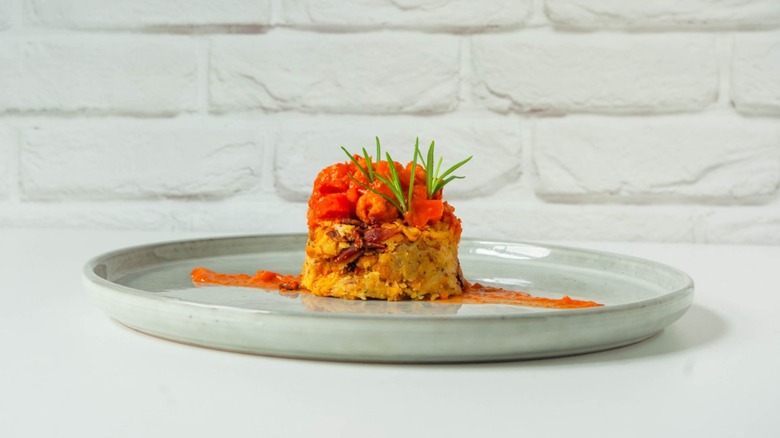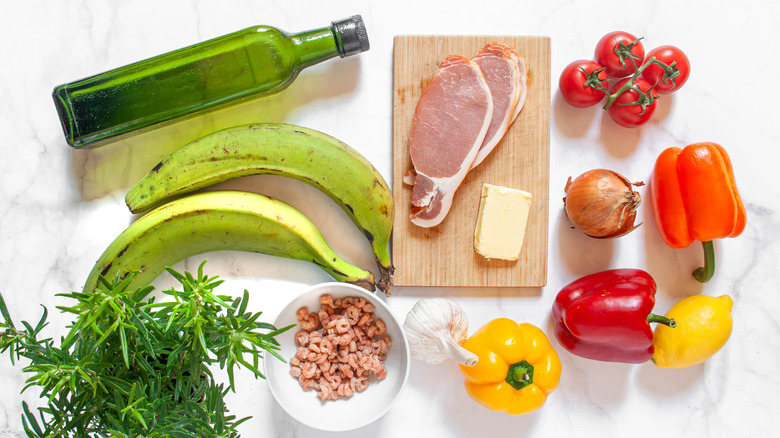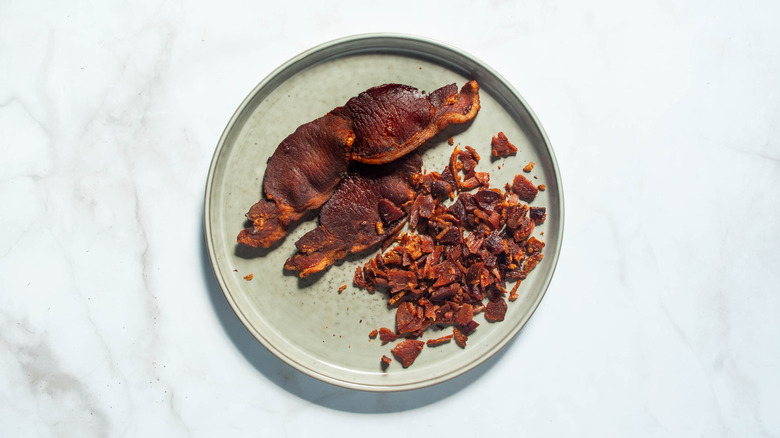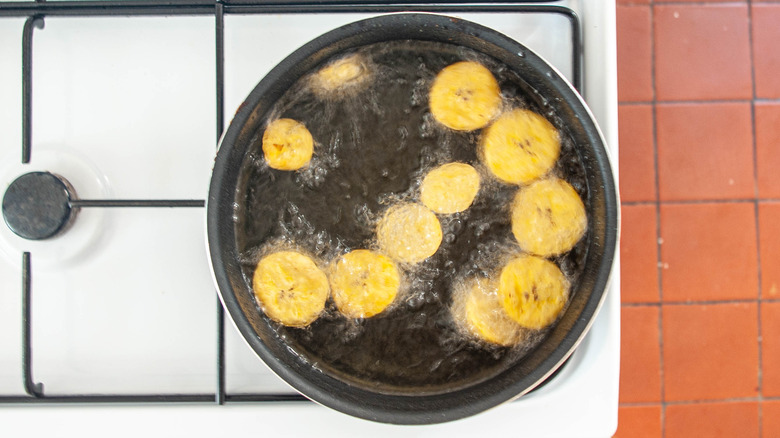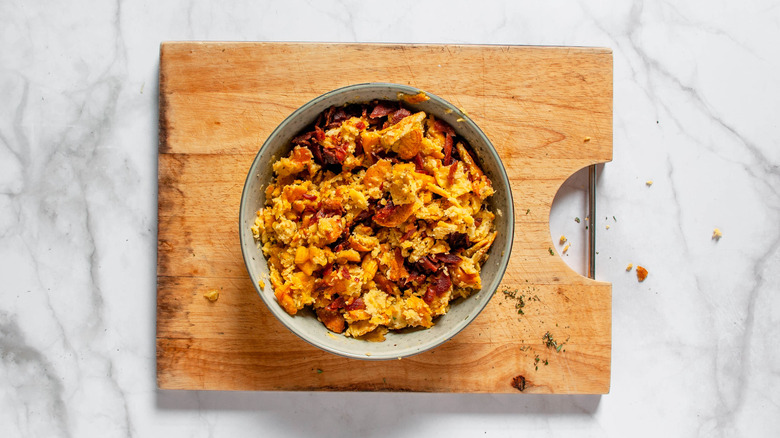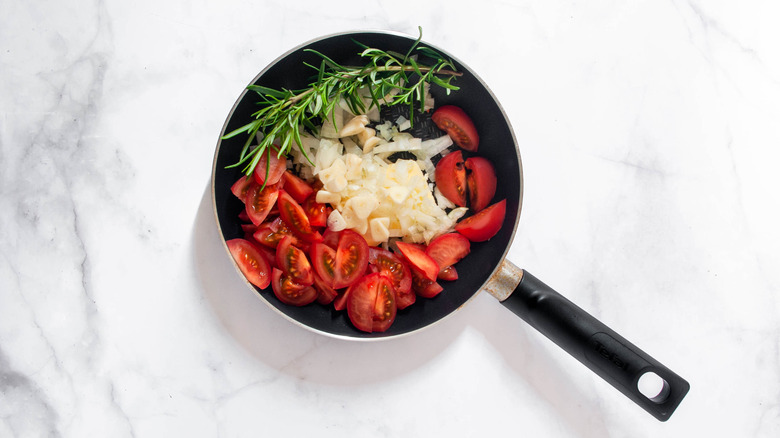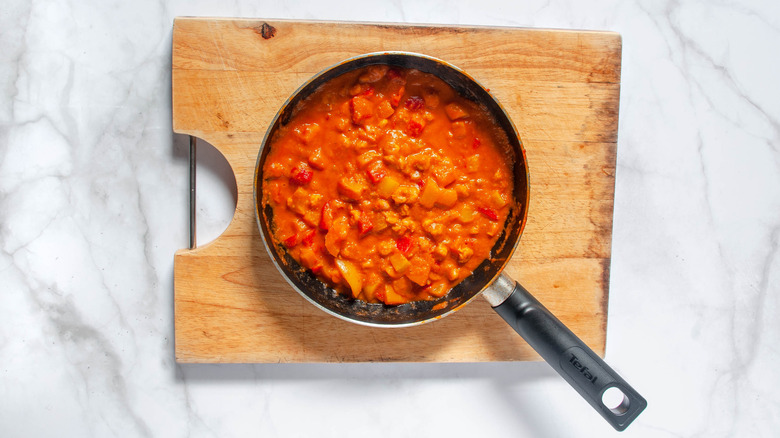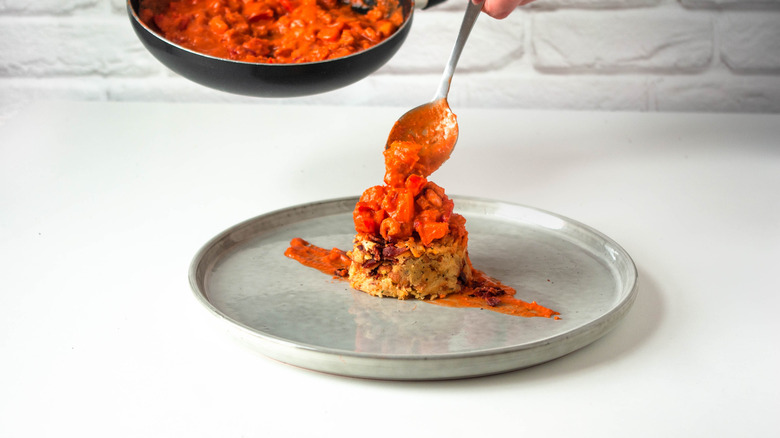Simple Shrimp Mofongo Recipe
Mofongo is a Puerto Rican dish that also shares its origins with the Dominican Republic, a neighboring island in the Caribbean Sea. As Dominican Cooking points out, both islands have culinary traditions descending from African, Spanish, and Taíno (indigenous Caribbean people) origins. On top of these influences, Middle Eastern and Chinese immigrants, as well as further European ties produced quite an overlap between the two cultures.
Ultimately, mofongo is believed to be a twist on the African dish fufú, although the latter makes use of other starchy vegetables such as cassava and yams. At its essence, mofongo is a fried plantain mash that has been seasoned with pork rinds and garlic. However, the recipe takes on many forms and can be used as a base for saucy main dishes or filled with meat or seafood for a complete meal.
Regardless of who was the first to turn fufú into mofongo, the dish has since become a staple in the cuisines of both islands. This fantastic version by Aušrinė Žygaitytė at Oceans of Food incorporates bacon into the plantain mash and covers the lot with a tomato-based shrimp and pepper sauce. You'll want to keep this recipe in your back pocket for an impressive dish to serve.
Gather the ingredients
To begin, you'll need to gather the ingredients to make your shrimp mofongo. You'll need 5 slices of bacon (regular or thick cut) to start — Žygaitytė tells us "a person can choose [the cut] based on their liking; it won't make a huge difference." It will be cooked, crushed, and mashed into the plantains to add plenty of flavor and texture. Next up is arguably the star of the dish: the humble plantain. You'll notice plantains ranging from green to black in the supermarket, but for this recipe green plantains are required due to their starchier texture and savory flavor. The large quantity of oil required is for frying, so be sure not to use your fanciest extra-virgin olive oil and stick to something with a high smoke point such as vegetable, soybean, or canola oil. Butter adds flavor and consistency to the plantain mash so that everything combines smoothly. Some garlic powder and fresh rosemary are also used to season the plantain mash.
The base of the sauce is made by panfrying onion, fresh rosemary sprigs, garlic, tomatoes, and tomato paste. You'll need a blender to mix the vegetables into a puree. Lemon juice adds a balance of acidity, while bell peppers add some texture and a bit of sweetness to the sauce. Finally, to make this dish suitable as a standalone main meal, small shrimp are included as the protein. Using smaller shrimp makes the extra cooking time minimal and means that you'll be scooping up a few shrimp in each forkful.
Bake the bacon in the oven until crispy and crumble it into pieces
To get started prepping your ingredients, set the oven to preheat to 400 degrees Fahrenheit. Lay the slices of bacon on a tray covered in tinfoil for an efficient way to catch all the grease. When the oven has reached the desired temperature, place the tray of bacon in the oven. Flip the slices occasionally for even cooking, and bake until the bacon is crispy, about 20 minutes. Once it is sufficiently crispy to be crushable, remove the tray from the heat and turn off the oven.
When the bacon has cooled down, crumble it either with your hands or with a cup or another hard object. Set the crushed bacon aside for later when it will be mixed into the plantain mash.
Slice and soak the plantains in water, then fry them in oil
If you've never used a plantain before, you'll notice they aren't as flexible as bananas and may require a knife to slit through the skin to facilitate peeling. Once you've removed the peel, slice the plantains and soak them in a bowl with water for 15 minutes. By soaking the plantains, they absorb some water, which helps them steam from the inside as they fry. This creates a softer texture, making it easier to mash the plantains after they have been fried. Soaking the plantains also removes some of the excess starch on the outside.
While the plantains are soaking, start heating the oil for frying in a pot on the stove at medium high heat. Once the plantains have finished soaking, pat them dry with a paper towel to avoid any volatile splatter when you add them to the oil. To test the oil for readiness, poke a wooden spoon into it and when light bubbles start forming around the spoon, the oil is ready. Add the plantains to the oil carefully to avoid burning yourself. Žygaitytė's number one recommendation was "Not to burn the plantain[s]," so keep a close eye on them, and to lower the heat if you notice they begin to burn. They should take about 13 minutes to fry to a nice golden color before they are ready to remove from the oil onto a plate.
Mash the plantains, season, and mix in the bacon
Now's the time to roll up your sleeves and put your weight into mashing up the plantains. A glass jar, cup, other solid objects, or even a potato masher will help – Žygaitytė notes the plantains will still be quite firm. Once the plantains begin to take on a smooth consistency, add in 2 tablespoons of butter, some thinly chopped rosemary, and a pinch of garlic powder to properly season the mash. Finally, mix in the crushed bacon that you set aside earlier. It will add plenty of flavor and depth, as well as a great texture. Are you salivating yet? Once everything is well combined, the plantain mash is ready and you can set it aside until you're ready to serve it.
Pan fry the onions, garlic, and tomatoes
Heat a medium-sized pan on the stovetop at medium heat. Add the remaining butter to the pan, and once it has melted, throw in the chopped onion, sprigs of rosemary, minced garlic, chopped tomatoes, and tomato paste. Panfry the vegetables, gently stirring to avoid burning. When the onions have softened, the vegetables are ready to remove from the heat. Take the rosemary sprigs out of the mix and toss the rest of the cooked vegetables into a blender or food processor. Mix them until they are pureed into a smooth blend.
Simmer the blended vegetables with the peppers and shrimp
Pour the pureed mixture back into your stovetop pan on medium heat. Squeeze in lemon juice to brighten and balance the flavor with some acidity. Add in the chopped peppers and the small shrimp and you're just minutes away from devouring the mofongo. Since the shrimp are so tiny, they'll only take a few minutes to cook in the sauce. Look to the peppers for readiness – they'll be crunchy at first and soften as they cook, so simmer the mixture until they have reached your desired softness.
Serve the shrimp mixture on top of the plantain mash
It's now time to plate the shrimp mofongo. For each serving, press the plantain mash into a ramekin and flatten it out. Flip the ramekin onto a plate to tip out the plantain mixture. If it doesn't come out easily, slide a small knife between the mash and the side of the ramekin to facilitate the process. With a spoon or ladle, pile the shrimp and vegetable sauce on top of the mound of plantain mash. There's no need to keep everything contained to the surface of the plantain. When you dig in with your fork, be sure to get a nice scoop of plantain mash and some saucy shrimp. You won't be disappointed!
If you're looking for some extra starches to complete your plate, rice makes a great accompaniment. If you want something fresh to balance out the rich flavors, look no further than a simple green salad. Grilled meat is always a good bet with plantains, according to Žygaitytė. This delicious shrimp mofongo turns up the wow factor, and is a treat you'll want to add to your regular rotation. It might even make you forget you're not enjoying it on a Caribbean island!
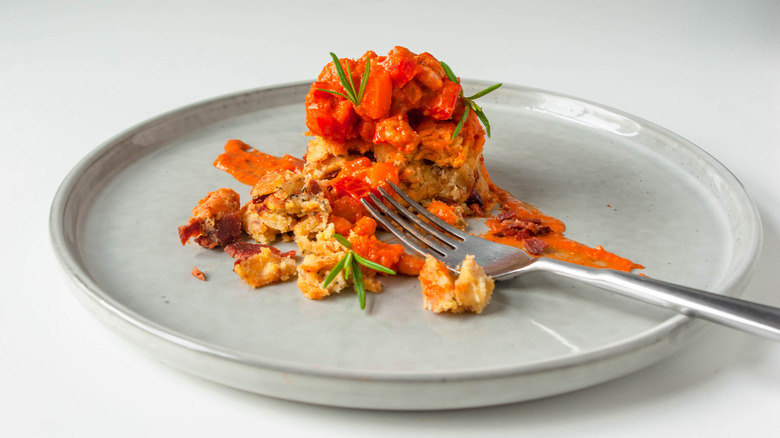
- 5 slices of bacon
- 2 green plantains
- 4 ¼ cups of oil for frying
- 3 tablespoons butter, divided
- 3-4 sprigs of fresh rosemary, divided (1 finely chopped)
- pinch of garlic powder
- ½ small onion, chopped
- 3 cloves of garlic, minced
- 1 medium tomato, chopped
- 1 tablespoon tomato paste
- 1 lemon, juiced
- 1 red bell pepper or ⅓ each of 3 different color bell peppers, chopped
- 2 ½ to 3 ½ ounces of small shrimp (about ¾ to 1 cup)
- Preheat the oven to 400 degrees Fahrenheit and place the bacon on a baking tray lined with tinfoil.
- Bake it until it is crispy, about 20 minutes, flipping it from time to time.
- Remove the bacon from the oven and crush it once it has cooled.
- Meanwhile, peel the plantains and cut them into slices.
- Soak them in water for 15 minutes, and then carefully dry the slices with a paper towel.
- Heat the oil in a pot and fry the plantains for about 13 minutes as they gain a golden color. Reduce the heat if they start to burn.
- Remove the fried plantains from the oil and mash them with a jar or something solid, as they will be pretty firm.
- While mashing the plantains, add in 2 tablespoons of butter, 1 sprig of thinly chopped rosemary, and the garlic powder. Mix in the crushed bacon, and set aside.
- Panfry the onion, remaining rosemary sprigs, minced garlic, chopped tomatoes, and tomato paste with the remaining butter.
- Once the onions are soft, take out the rosemary sprigs and blend the cooked vegetables in a food processor or blender.
- Return the pureed mix to the pan and add the lemon juice, chopped peppers, and shrimp.
- Simmer until the pepper is soft enough for your liking.
- For each serving, squeeze the plantain mix into a ramekin and flip it out onto a plate. If it doesn't fall out easily, take a small knife and run it through the side between the plantain and the ramekin.
- Spoon the pepper and shrimp mixture over the plantain mash and serve.
| Calories per Serving | 950 |
| Total Fat | 80.4 g |
| Saturated Fat | 17.7 g |
| Trans Fat | 0.7 g |
| Cholesterol | 133.0 mg |
| Total Carbohydrates | 48.8 g |
| Dietary Fiber | 5.9 g |
| Total Sugars | 22.8 g |
| Sodium | 618.6 mg |
| Protein | 15.2 g |
